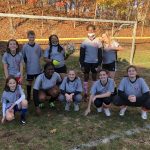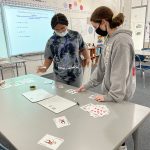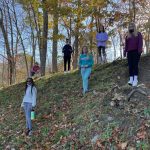Winter break is one week away and the Middle School community is busy sharing their energetic festive spirit. All the Middle School students recorded their music video with Mr. Erik and the video should be available for viewing soon. We also began decorating our respective advisory doors with this years theme of Winter Wonderland. In addition, the grade 8 class completed the gift wrapping for all the wonderful donations brought in for the Family Gift Drive to support two families.
Next week we will be celebrating the students great accomplishments in 2021 with a fun holiday party on Friday December 17th. Please remember to have your child bring in their secret snowman gift (10$ spending limit) and any treats to share for our party. A respective SignUp genius was emailed to all families in order to help us bring in all the goodies we will need.
HUMANITIES:
6th grade Humanities class has been working on their independent reading novel this week. Individual goals are set for reading and the accompanying assignments will guide book discussions. This week, students have discussed and written about the importance of the setting in a plot as well, identifying the conflict, and making predictions for how the conflict will be resolved. Additionally, students completed another unit of vocabulary.
7th grade Humanities classes are continuing to work through Baba Wague Diakite’s memoir, A Gift From Childhood, that focuses on growing up in Mali during the second part of the 20th century. In addition to book discussion, students learned about the traditional ceremonies and celebrations surrounding boys becoming adults in Mali as well as Kenya. 7th grade students also learned about the qualities of a fable, since many of the stories that Baba tells could be considered fables. The class has begun prewriting for their own fables that will be drafted next week. Finally, students completed a unit of vocabulary.
In 8th grade Humanities, students learned about the Age of Exploration. This involved taking a deeper look at explorers, their reasons for wanting to travel west, where they ended up exploring, and the subsequent impacts. Students also continued reading their class novel, If I Ever Get Out of Here by Eric Gansworth. Finally, 8th grade students completed a unit of vocabulary.
MATH:
In Transition class, students began working through chapter 7 in the UCSMP textbook. We will revisit chapter 6 in the new year all together. This class is learning about area and perimeter of 2D shapes, multiplying fractions and applying the commutative and associative property of multiplication. Students are also practicing how to use the distributive property when multiplying large values.
In Algebra class, students can successfully convert rates to a different unit and use ratios to compare two quantities. This class is practicing how to interpret percentile questions and how to solve proportions using a cross-multiplication method. We will conclude our learning of chapter 5 next week and encourage all students to begin long term studying for the chapter test scheduled for Tuesday December 14th.
In Geometry class, students are continuing to work through proof statements using properties of isometries. This class can successfully label alternate interior and exterior angles in a figure, as well as construct equilateral triangles from three non-collinear points. We will continue to work through the triangle-sum, quadrilateral-sum and polygon-sum theorems next week.
Math Joke: What’s the one shape you should avoid at all costs?…..a TRAP-ezoid.
SCIENCE:
This week in Earth Science, students have worked on locating the epicenter of an earthquake using data obtained by 3 seismic stations. Students were tasked with identifying the difference in arrival of P and S waves recorded from a seismograph which were used to determine the distance to the epicenter. Students graphed circles on a map, representing areas of seismic activity through earth’s crust. By graphing 3 different seismograms, students were able to determine the epicenter by locating the area of overlap of the 3 circles.
In Physical Science, students finished their stop motion video representations of covalent and ionic bonding of atoms. Students selected 2 molecules that each represented ionic and covalent bonds. The videos depicted the transfer/exchange of electrons between atoms that resulted in a specific type of bond. Throughout working on this project, students became familiar with the properties elements have and how the history of the periodic table of elements.
In Life Science, students finished their stop motion video representations of meiosis. Students created a stop motion video that illustrated the 4 main stages of meiosis (Prophase, Metaphase, Anaphase, Telophase). Students were able to show the difference between mitosis and meiosis as in meiosis, genetic variation occurs during prophase by the exchange of DNA by crossing over. Each student worked hard meeting each of the objectives.



























































































































































































